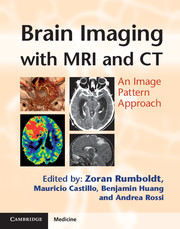Book contents
- Frontmatter
- Contents
- List of contributors
- List of abbreviations
- Preface
- Section 1 Bilateral Predominantly Symmetric Abnormalities
- Section 2 Sellar, Perisellar and Midline Lesions
- Section 3 Parenchymal Defects or Abnormal Volume
- Section 4 Abnormalities Without Significant Mass Effect
- Section 5 Primarily Extra-Axial Focal Space-Occupying Lesions
- Section 6 Primarily Intra-Axial Masses
- 152 Acute Infarction
- 153 Glioblastoma Multiforme
- 154 Therapy-Induced Cerebral Necrosis (Radiation Necrosis)
- 155 Non-Hemorrhagic Metastases
- 156 Cerebral Abscess
- 157 Cerebral Toxoplasmosis
- 158 Primary CNS Lymphoma
- 159 Tumefactive Demyelinating Lesion
- 160 Tuberculoma
- 161 Oligodendroglioma
- 162 Low-Grade Diffuse Astrocytoma
- 163 Gliomatosis Cerebri
- 164 Mitochondrial Myopathy, Encephalopathy, Lactic Acidosis, and Stroke-Like Episodes (MELAS)
- 165 Pleomorphic Xanthoastrocytoma (PXA)
- 166 Ganglioglioma
- 167 Neurocysticercosis – Parenchymal
- 168 Dilated Perivascular Spaces
- 169 Neuroepithelial Cyst
- 170 Subependymal Giant Cell Astrocytoma (SEGA)
- 171 Subependymoma
- 172 Ependymoma
- 173 Pilocytic Astrocytoma
- 174 Medulloblastoma
- 175 Hemangioblastoma
- 176 Lhermitte–Duclos (Cowden Syndrome)
- 177 Hypertensive Hematoma
- 178 Amyloid Hemorrhage – Cerebral Amyloid Angiopathy
- 179 Cortical Contusion
- 180 Hemorrhagic Neoplasms
- 181 Hemorrhagic Venous Thrombosis
- 182 Arteriovenous Malformation
- 183 Cavernous Angioma (Cavernoma)
- Section 7 Intracranial Calcifications
- Index
- References
165 - Pleomorphic Xanthoastrocytoma (PXA)
from Section 6 - Primarily Intra-Axial Masses
Published online by Cambridge University Press: 05 August 2013
- Frontmatter
- Contents
- List of contributors
- List of abbreviations
- Preface
- Section 1 Bilateral Predominantly Symmetric Abnormalities
- Section 2 Sellar, Perisellar and Midline Lesions
- Section 3 Parenchymal Defects or Abnormal Volume
- Section 4 Abnormalities Without Significant Mass Effect
- Section 5 Primarily Extra-Axial Focal Space-Occupying Lesions
- Section 6 Primarily Intra-Axial Masses
- 152 Acute Infarction
- 153 Glioblastoma Multiforme
- 154 Therapy-Induced Cerebral Necrosis (Radiation Necrosis)
- 155 Non-Hemorrhagic Metastases
- 156 Cerebral Abscess
- 157 Cerebral Toxoplasmosis
- 158 Primary CNS Lymphoma
- 159 Tumefactive Demyelinating Lesion
- 160 Tuberculoma
- 161 Oligodendroglioma
- 162 Low-Grade Diffuse Astrocytoma
- 163 Gliomatosis Cerebri
- 164 Mitochondrial Myopathy, Encephalopathy, Lactic Acidosis, and Stroke-Like Episodes (MELAS)
- 165 Pleomorphic Xanthoastrocytoma (PXA)
- 166 Ganglioglioma
- 167 Neurocysticercosis – Parenchymal
- 168 Dilated Perivascular Spaces
- 169 Neuroepithelial Cyst
- 170 Subependymal Giant Cell Astrocytoma (SEGA)
- 171 Subependymoma
- 172 Ependymoma
- 173 Pilocytic Astrocytoma
- 174 Medulloblastoma
- 175 Hemangioblastoma
- 176 Lhermitte–Duclos (Cowden Syndrome)
- 177 Hypertensive Hematoma
- 178 Amyloid Hemorrhage – Cerebral Amyloid Angiopathy
- 179 Cortical Contusion
- 180 Hemorrhagic Neoplasms
- 181 Hemorrhagic Venous Thrombosis
- 182 Arteriovenous Malformation
- 183 Cavernous Angioma (Cavernoma)
- Section 7 Intracranial Calcifications
- Index
- References
Summary
Specific Imaging Findings
Pleomorphic xanthoastrocytomas (PXAs) generally present as supratentorial hemispheric peripherally located cystic masses (60%) with a solid portion that abuts the meninges. The solid nodule enhances with contrast and may result in enhancement of a “dural tail” (70%) or scalloping of the adjacent inner table of the skull. They are most commonly found in the temporal, frontal, and parietal lobes but may occur anywhere in the cerebral hemispheres and even within the ventricles. Their size and degree of contrast enhancement are variable and calcifications and hemorrhage are rare. On MRI, the signal intensity of the solid tumor is variable but the cyst is nearly always of signal intensity similar to CSF on all sequences. Rarely, brain invasion, metastases, and/or necrosis are seen.
Pertinent Clinical Information
PXAs are tumors of young adults (with about 60% found below 18 years of age) without gender predilection. These are slow growing tumors which most commonly present with chronic seizures, headaches, and dizziness. Survival rates are better than 70% at 10 years after the initial diagnosis, however they may degenerate into higher grades. Surgery is the treatment of choice with gross total resection giving the best results, and re-resection is done for recurrences. Chemotherapy and radiation may be used for unresectable tumors as well as for primary and recurrent anaplastic PXAs, but their role is not clearly established. The only features that correlate with survival are the extent of initial resection and mitotic rate.
Information
- Type
- Chapter
- Information
- Brain Imaging with MRI and CTAn Image Pattern Approach, pp. 341 - 342Publisher: Cambridge University PressPrint publication year: 2012
